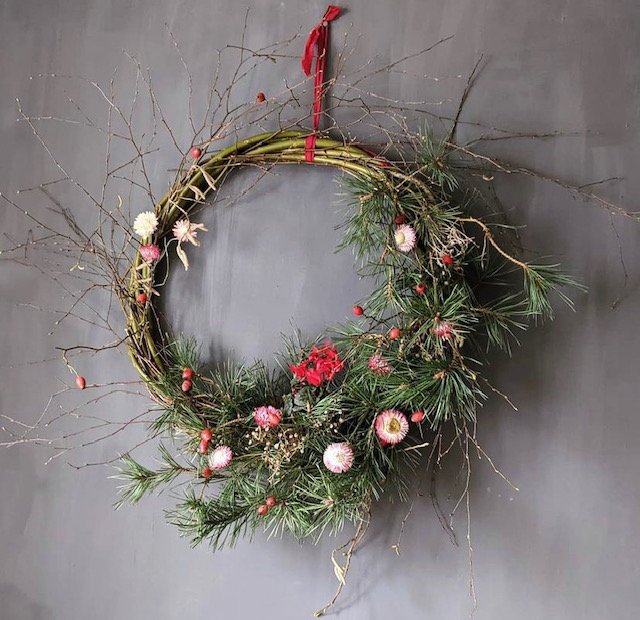Recently there’s been some drama in my greenhouse. My autumn sown hardy annuals – the ones that I laboriously grew from seed collected in September – are all gone, bitten the (fungal) dust.
My greenhouse thermometer tells me that the glass house has seen highs of 30 degrees during the day and lows of minus two at night. I’ve had the frost cloths on tender plants and sometimes forgotten to take them off, possibly smothering and sweltering the plants underneath. I’ve had the vents of the greenhouse closed to keep the mice out (I accidentally left them open one night and mice crawled up the dahlia stakes resting against the benches, and they did away with a whole crop of Orlaya and Nigella overnight) so airflow was lacking. I’d basically created a perfectly fusty fungal festival and lost everything. At the point where a healthy lush plant connected to the soil, the stem was weak, whittled away and collapsed.
The disease is called ‘dampening off’ and although it’s common, I have not lost crops at this magnitude before. I admittedly nearly always lose my autumn sown snaps but not larkspur and scabious. Some googling suggests sprinkling cinnamon on top of the soil around the stem helps but the cost of doing this on a large scale… I might as well give up. Consulting the oracle that is my local Flowers from The Farm What’s App group, a group of highly experienced growers, the advice was to fill a deep dish with clean water and soak from below instead of using a can or sprayer from above. At the back of my mind, I know I know to do this, but I am lazy and have not implemented this practice. This is my wake-up call to stop taking shortcuts.
It's incredibly hard not to get dispirited when growing for a living. When it’s a hobby, it’s a bonus when things survive. You take the win with pride. When it’s your living, you see all the failures as a colossal waste of time, money and effort and it is easy to feel like an utter failure and forgot the wins. I am having to have serious words with myself on a near daily basis about what I have managed to achieve and what I can learn from my fuck ups.
My partner showed me an interesting diagram called The Dunning-Kruger Effect, which I think summarises my journey perfectly. At the start of my pipe dream, I knew nothing about growing or floristry. I threw some flowers together from my garden for my own wedding and thought – this is marvellous, what fun, I’m a natural!
I did a morning’s floristry course and then put together my sister’s wedding flowers. I was so incredibly passionate about my newfound hobby, using garden-grown climate friendly flowers for weddings, that I bought some books on growing and floristry and quit my career.
I had some savings and a few books and buckets upon buckets of determination and confidence. I turned my back on ten years of experience in teaching, editing/writing and marketing, a pension and income security.
You can see this stage at the beginning of the chart. According to Wikipedia this stage is when people with limited competence overestimate their ability. An inaccurate assessment of one’s ability leads to one making bad decisions such as choosing a career one is unfit for. Ta-da! This is me.
I quickly found out I could grow nothing well from seed. And I mean nothing. I signed up for an online growing course and everything went immediately over my head. I had a small city garden. I was growing very spindly seedlings on windowsills. Everyone else on the course had a polytunnel, a greenhouse and land. That was the first realisation - that I had a lot to achieve but I was still peaking. I was still in the stage where over confidence was going to help me achieve my unrealistic goal.
My next move was to find a house with land. This was hard. I had family needs to consider. I picked the best house with the size of land I wanted – who cared if it was on a 45-degree hill, the second tallest in Norfolk, covered in brambles and bindweed. Anything was possible if I set my mind to it! I ditched my city girl white trainers in favour of wellies and got digging.
Soon after this, my confidence finally began to drop. Indeed, it plummeted. Hard. I could grow nothing on the slope. The land was entirely feral. Rural life was difficult and isolating. I was right at the bottom of the curve, committing all my savings, desperate to make it work and crying into piles of actual shit as I shovelled horse manure onto my garden.
Four years later and I have a studio, a polytunnel, a greenhouse and thirteen flat growing levels. I am still making lots of mistakes, but each mistake gives me valuable experience, helping me on my journey to become an expert. I am on the upward curve now - crops that previously baffled me, such as Ranunculi, I can predictably grow.
This year I am attempting more ‘expert’ level seed sowing with crops such as Lisianthus and some perennials that require tedious moving of pots inside and outside to mimic Spring conditions. I’d love it if I could keep my spring-sown Snaps alive to the planting out stage. In Autumn, I will still sow hardy annuals and I will leave the greenhouse vents open and water seedlings from below just to see what success I have. I’d like to return to this blog next February and assess if I’m any further along my journey to become an expert grower who doesn’t need to buy in wedding flowers from far superior growers.


















































